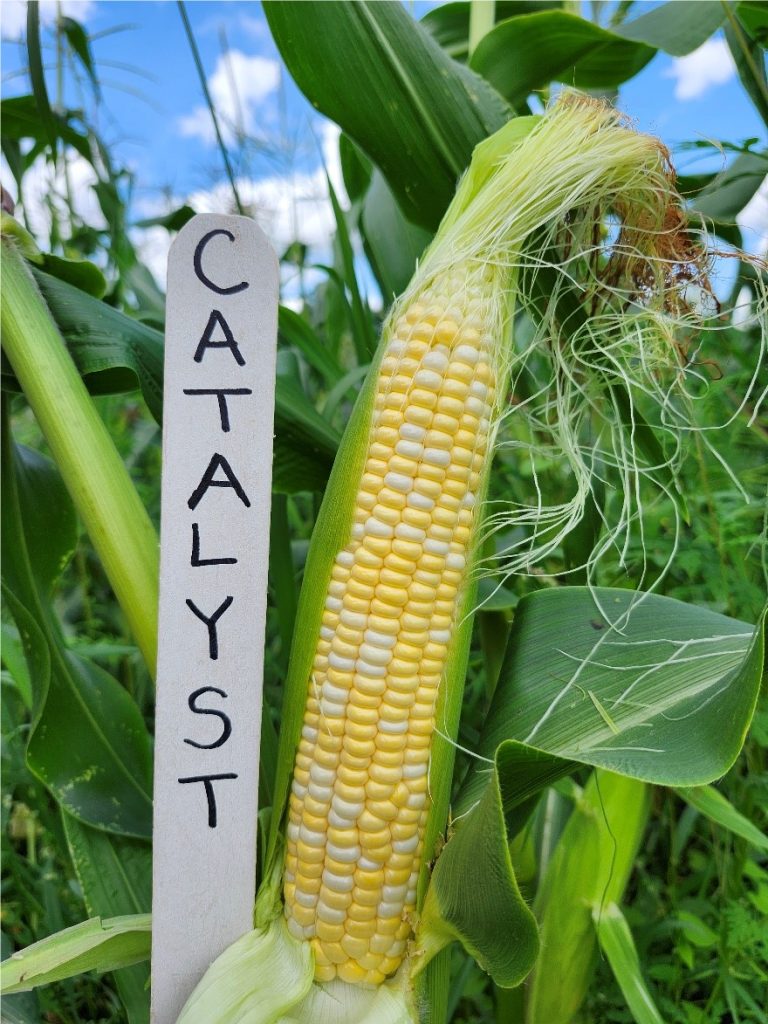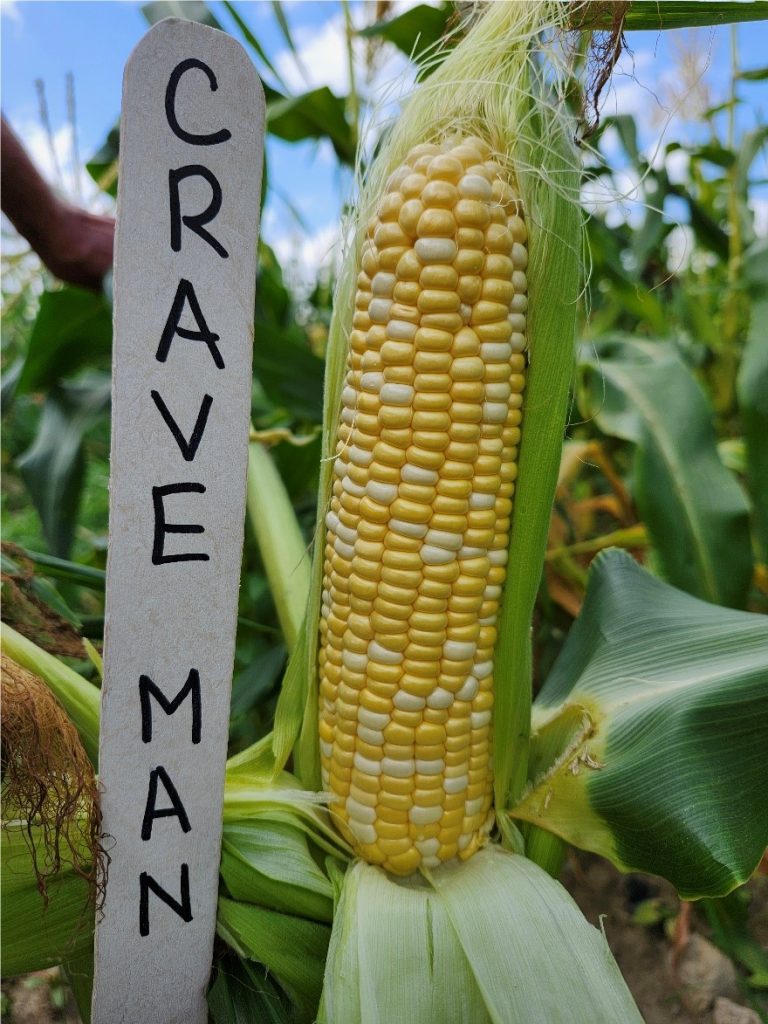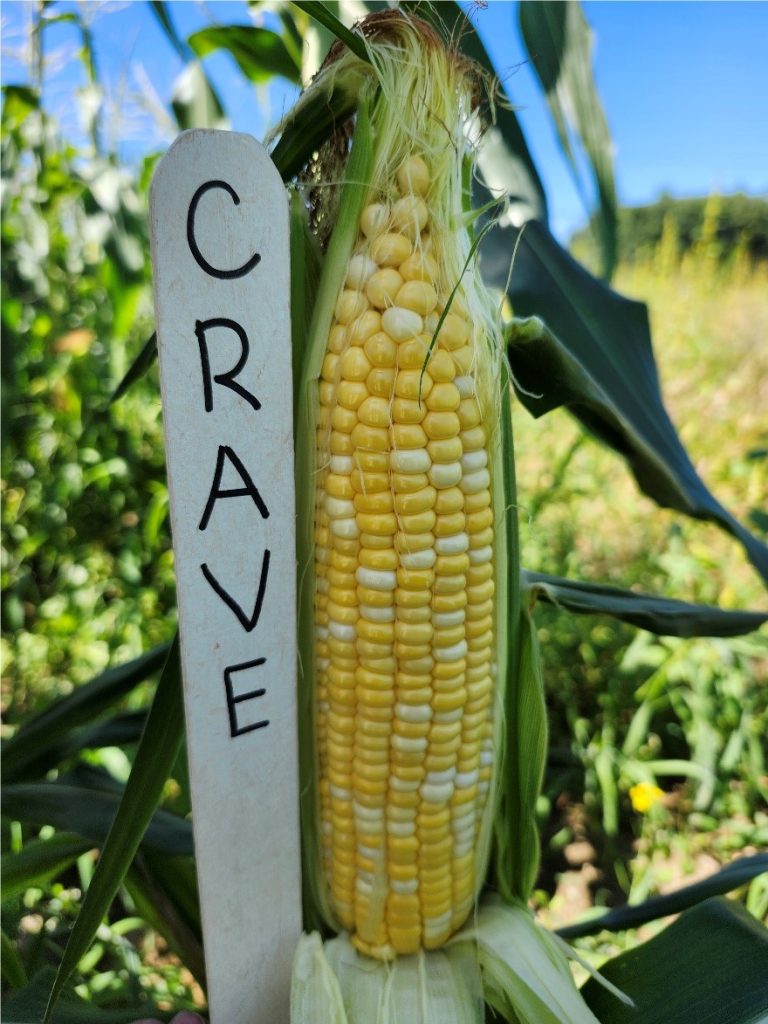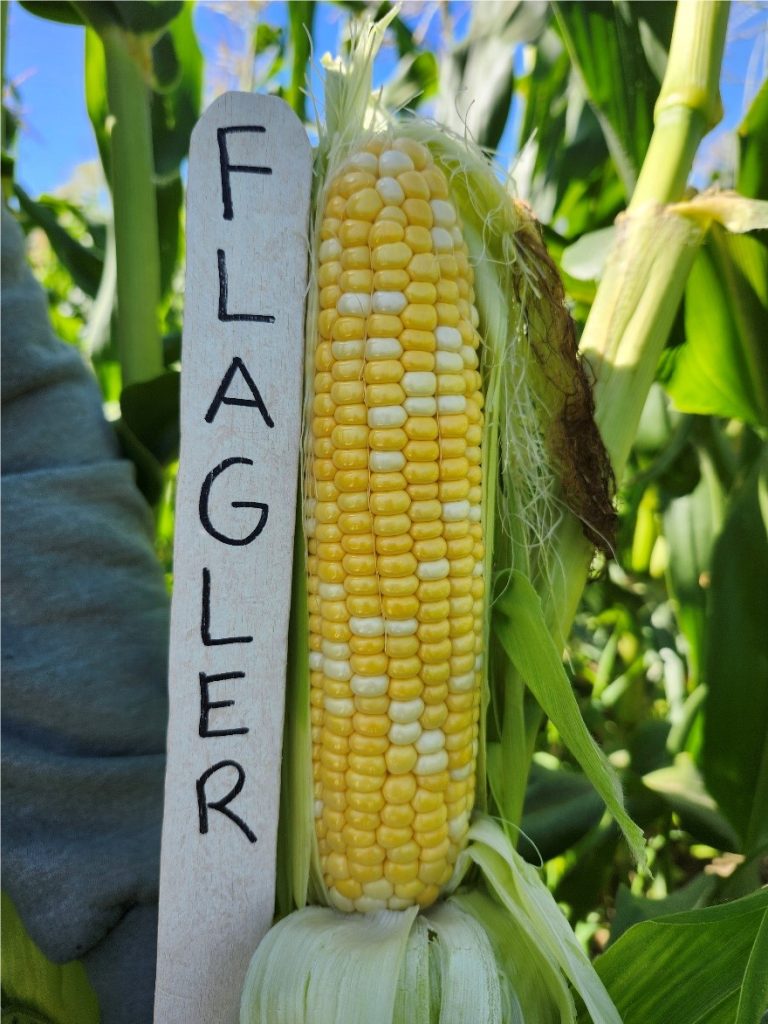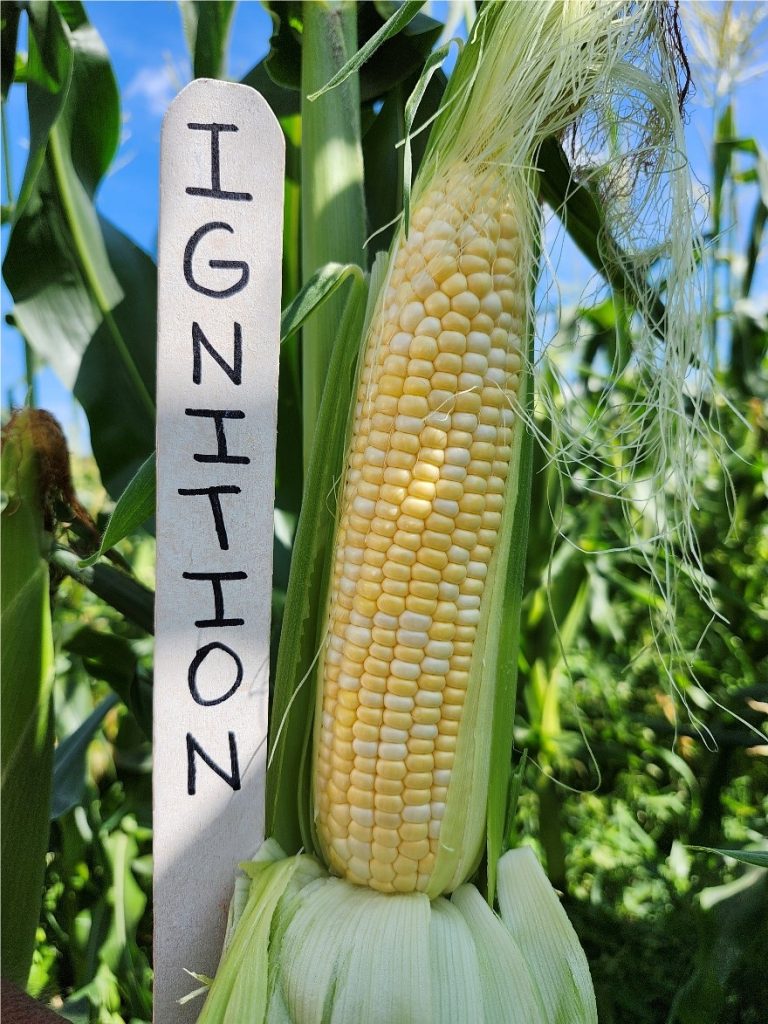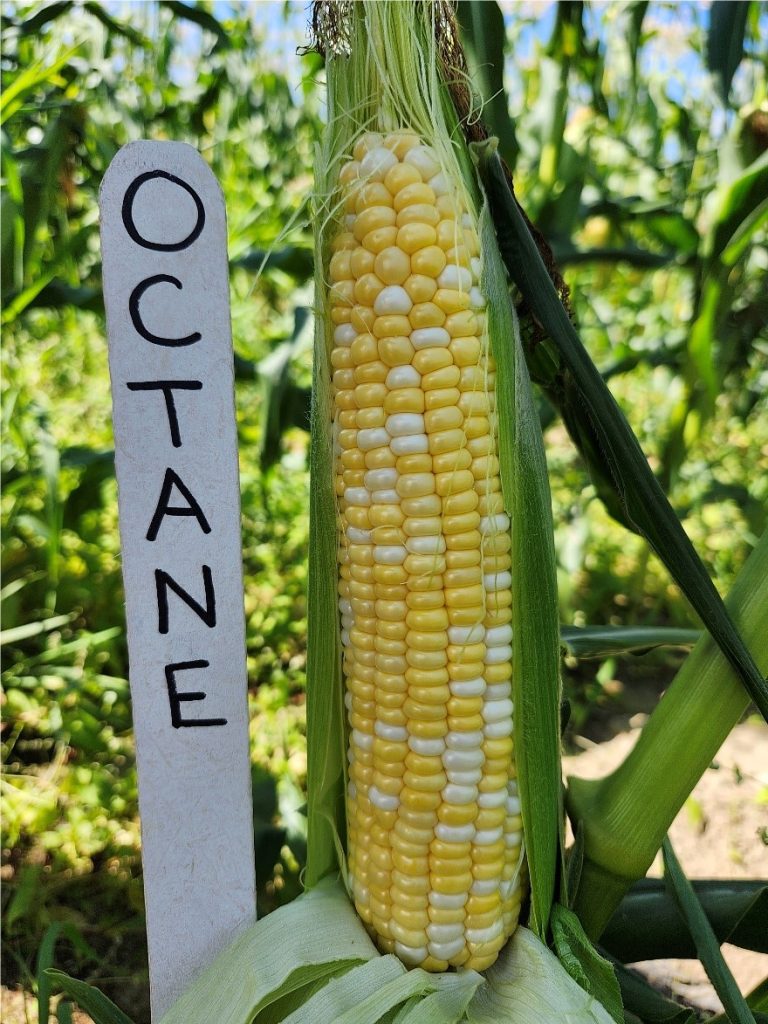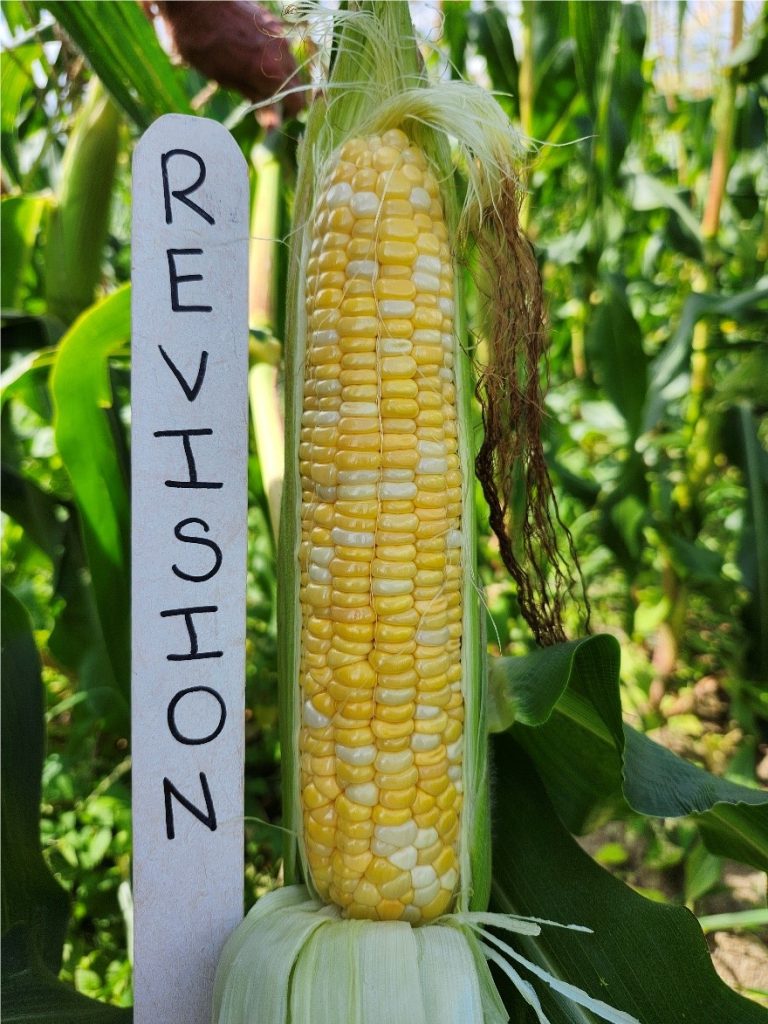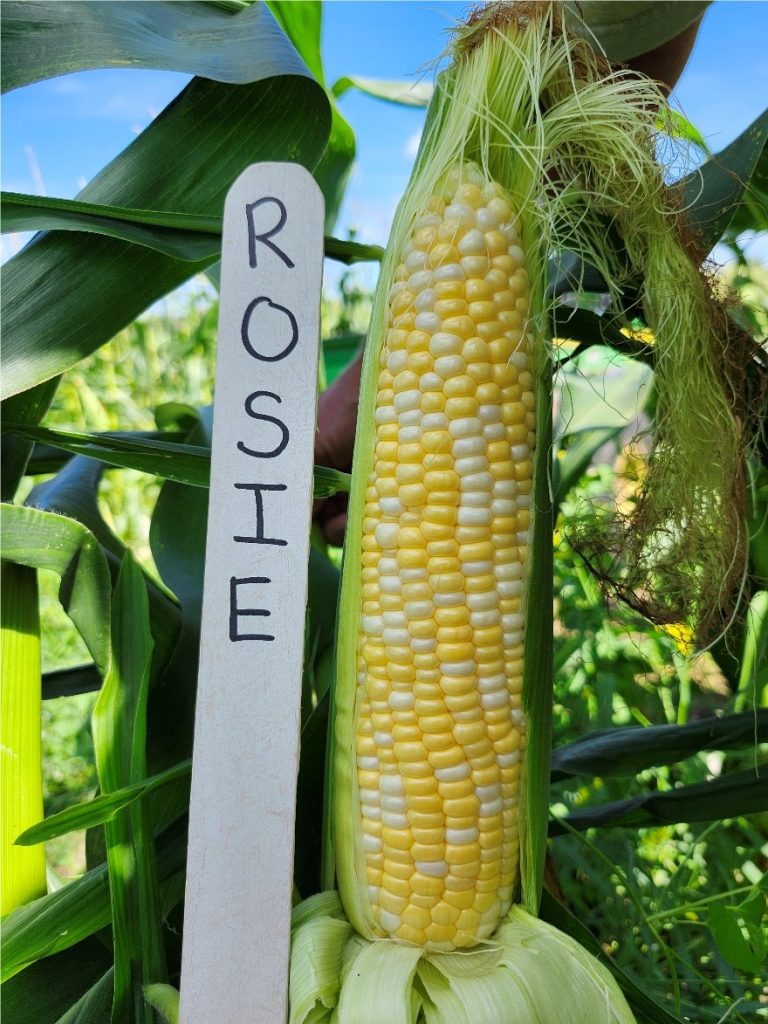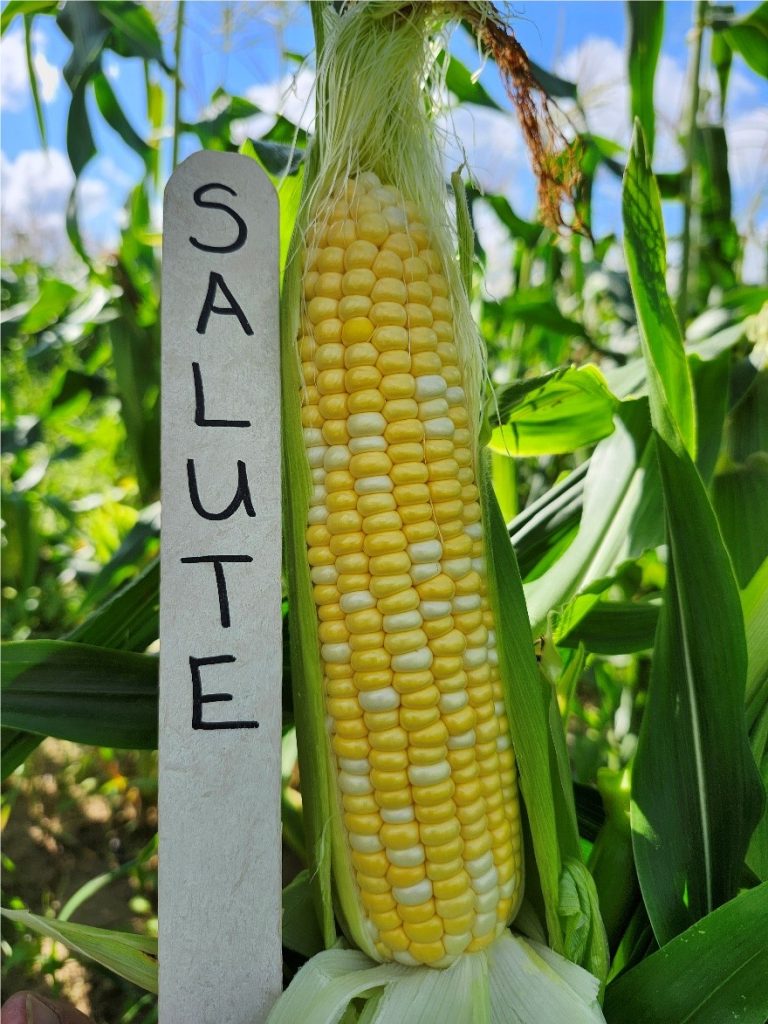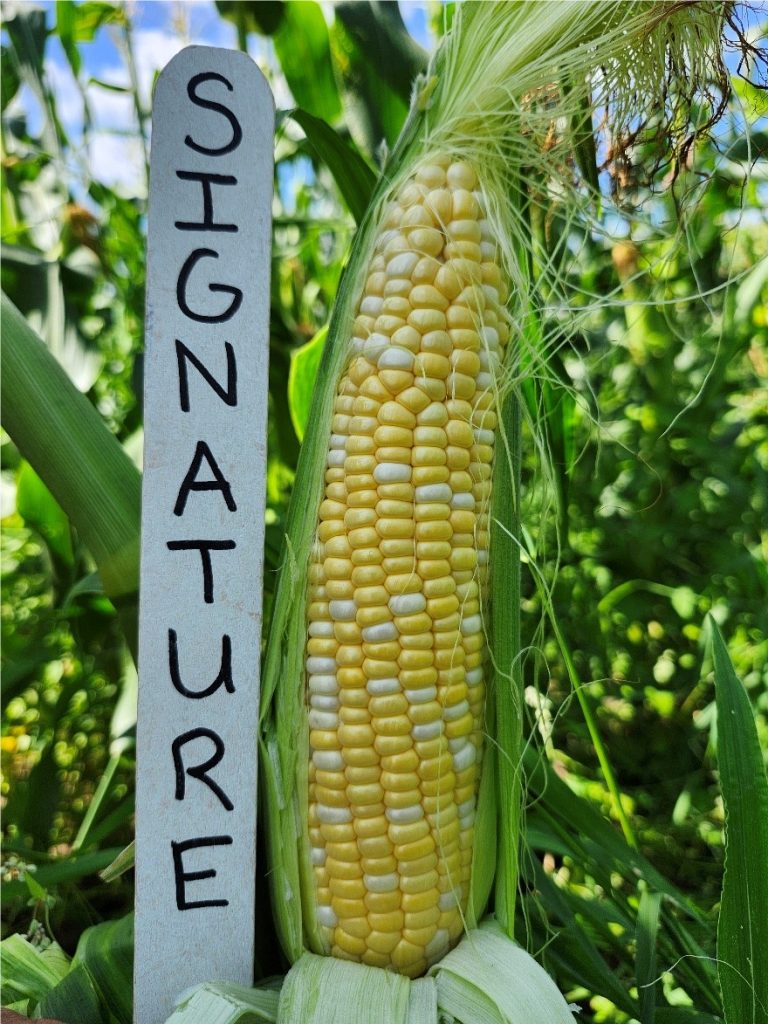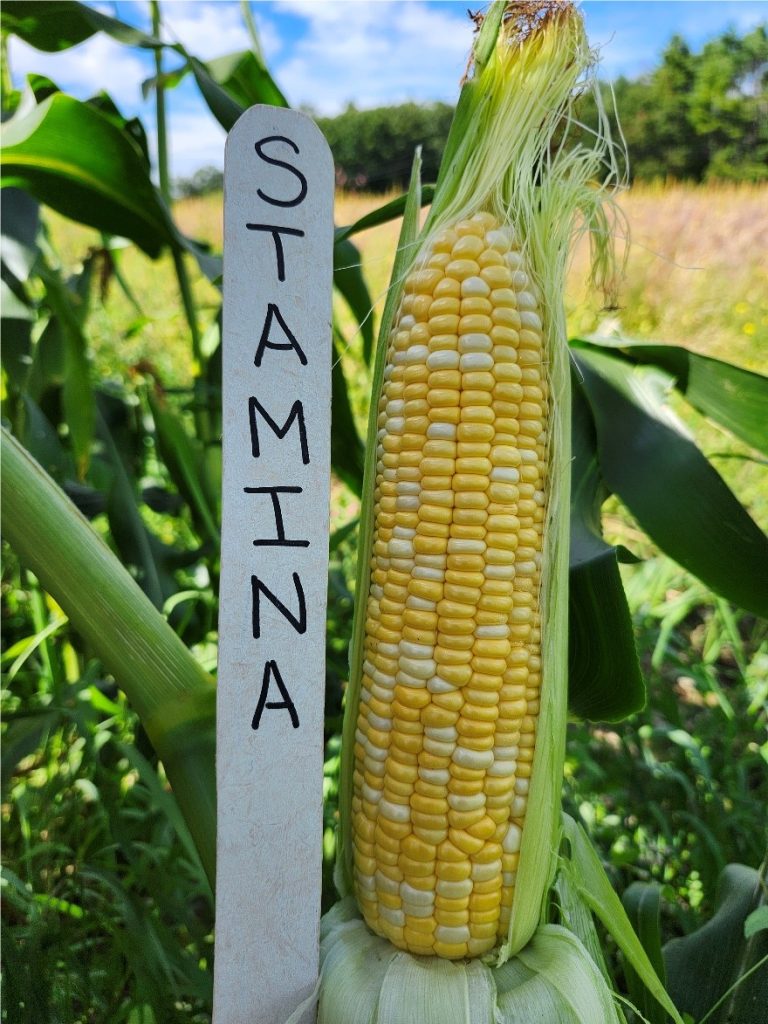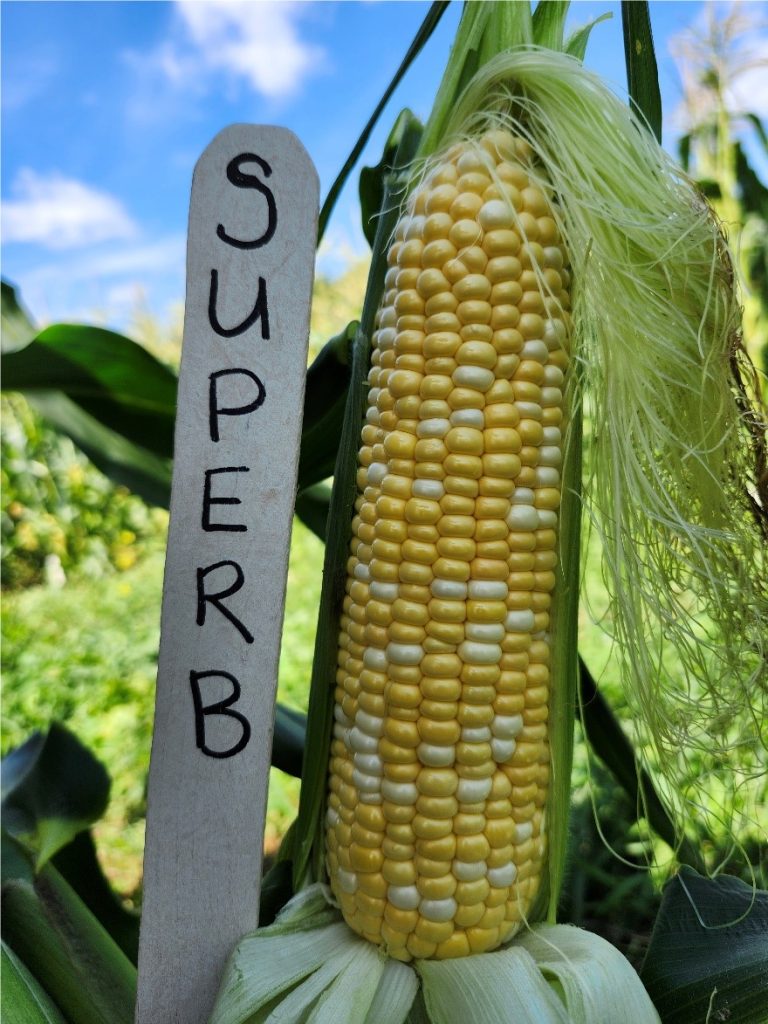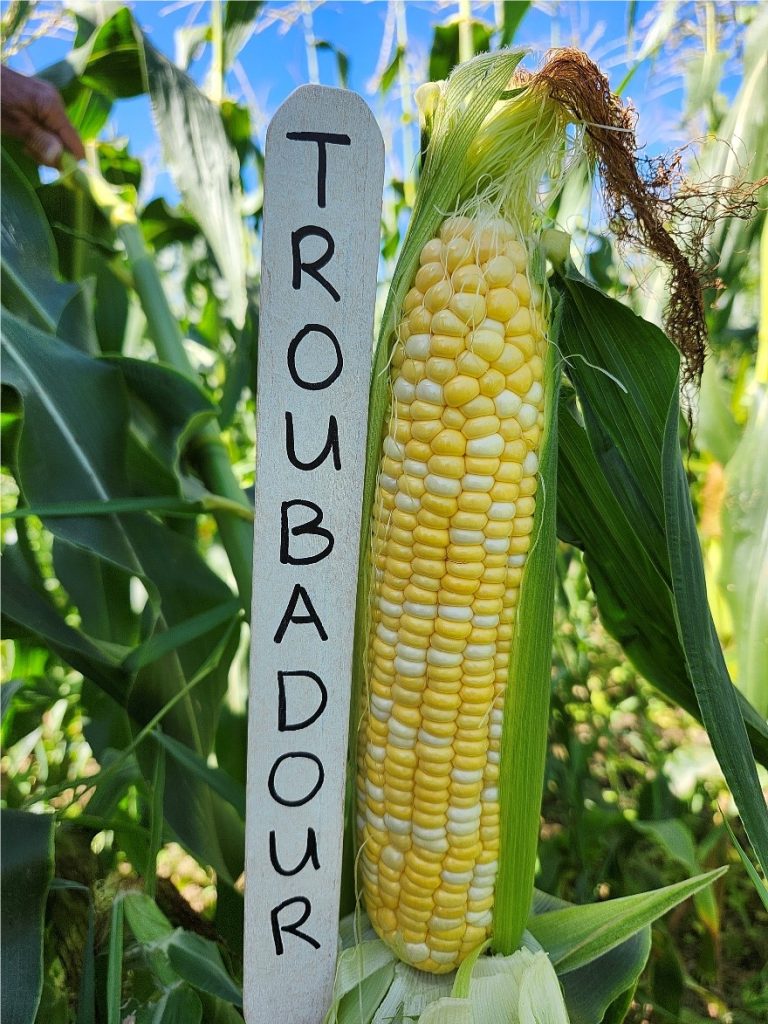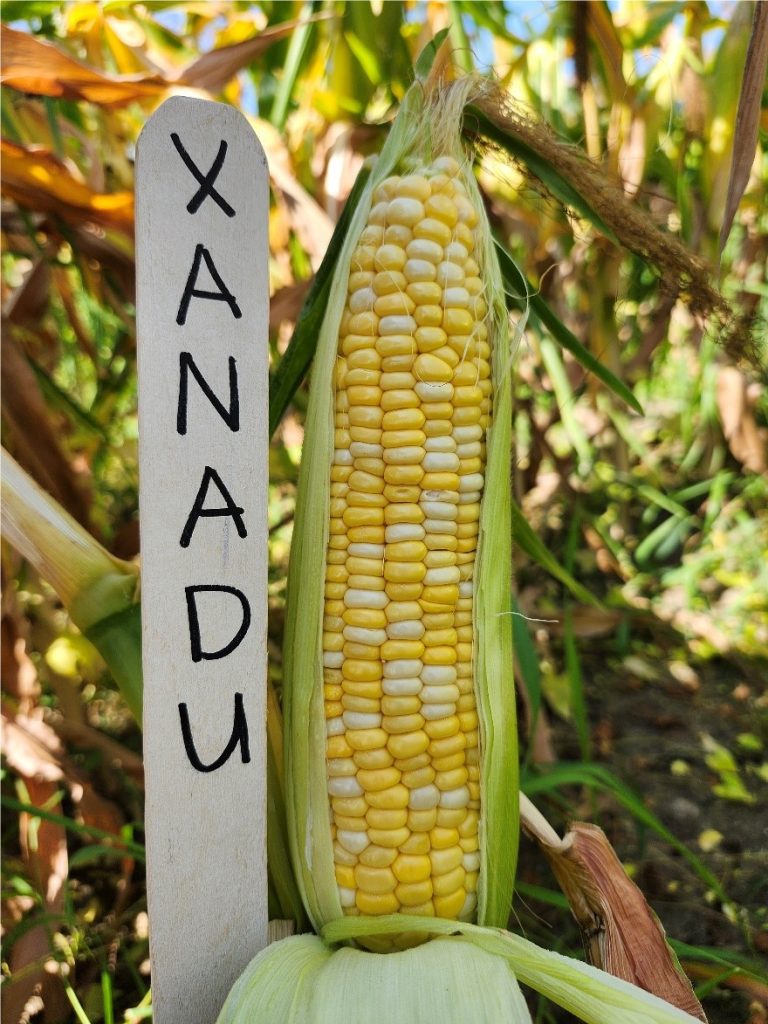Sweet Corn Evaluations: 2024 Research Report
Mark Hutton, University of Maine Cooperative Extension Vegetable Specialist
David Handley, University of Maine Cooperative Extension Small Fruit & Vegetable Specialist
Peyton Ginakes, University of Maine Cooperative Extension Research Associate
Twenty super sweet bicolor sweet corn varieties were evaluated at the University of Maine’s Highmoor Farm in Monmouth, ME in 2024. The field evaluation was laid out in a replicated complete block design with three blocks. Sweet corn was manually planted using jab planters on June 6. Seeds were spaced 12” apart within rows spaced 36” apart. Each plot contained four 20’-long rows, and data were collected from the two central rows. Qualitative attributes were measured on eight individual ears per plot.
Data are shown in Table 1 below. Entries highlighted yellow denote the best performing varieties for that trait, while those highlighted orange show the worst.
Catalyst XR, Bolt XR, and Kickoff were the earliest varieties. The dry fall in 2024 allowed harvest to extend longer than usual, which benefitted 90+ day varieties Matriarch, Octane, Patriarch, Crave Man, Revision, Salute, Stamina MXR, and Remedy.
Plant stand was acceptable (90% +) among all varieties. Bolt, Kickoff, Superb MXR, and Patriarch had the best stands; Catalyst and Octane had the poorest stands.
Height of the ears on the stalk impacts how easy it is to hand harvest the crop. Ears set higher off the ground are preferred over ears low to the ground to save repetitive bending over to pick them. In this trial, as in previous trials, early maturing varieties tended to have shorter stalks and ears placed closer to the ground. Early varieties Catalyst XR, Bolt XR, and Kickoff, along with Patriarch and Crave Man, had ears very low on the stalk (<18”), while Ignition and the late-maturing cultivars Salute, Stamina MXR, and Remedy sat very high on the plant (>22”).
Most varieties were relatively easy to pick and came off the stalk with minimal effort. Notable exceptions included Ignition, Inspiration, and Revision, which were rated poorest for picking ease.
Tip cover was poor for many varieties in this trial, and may be related to the dry conditions during the later part of the growing season. Only Catalyst XR, Bolt XR, Ignition, Crave Man, and Revision had well-covered ear tips. Rosie, Xanadu, Flagler, Troubadour, Crave, Inspiration, Matriarch, Octane, and Patriarch had exposed or nearly exposed tips, making them more susceptible to bird and insect damage.
Yield was acceptable among all varieties and somewhat related to stand, as would be expected. Bolt XR, Kickoff, Rosie, Superb MXR, Xanadu, Flagler, Octane, Patriarch, Salute, and Stamina MXR had the greatest yields averaging at least 21 ears per row. The lowest yielding varieties included Ignition, Octane, Crave Man, and Revision, which produced 17 ears or less per plot.
Ear length was very good for all varieties in this trial (>7”). Revision and Remedy, relatively late varieties, had the largest ears at greater than 8.5” long. Crave Man and Bolt had the shortest ears at just over 7 inches.
The number of rows of kernels on each ear is another measure of ear quality. Higher row numbers give the ear a more refined look and greater consumer appeal. Superb MXR, Xanadu, Matriarch, and Crave Man had the greatest average number of rows of kernels per ear at 18. Catalyst XR, Patriarch, and Remedy had the lowest row numbers, averaging 14-15 rows each.
| Cultivar | Days to Harvest | Stand (plants/row) | Ear Height (in) | Ear Height Range (in) | Picking Easea | Tip Cover (in) | Yield (ears/row) | Ear Length (in) | Kernel Rows/Ear |
|---|---|---|---|---|---|---|---|---|---|
| Catalyst XR | 71 | 18.0 | 15 | 10 – 21 | 2.5 | 3.0 | 18.0 | 8.2 | 14 |
| Bolt XR | 71 | 25.0 | 14 | 9 – 19 | 3.0 | 3.0 | 24.7 | 7.4 | 17 |
| Kickoff | 76 | 25.0 | 17 | 14 – 24 | 1.8 | 2.2 | 21.7 | 8.4 | 16 |
| Ignition | 78 | 21.3 | 24 | 18 – 28 | 1.5 | 2.8 | 16.3 | 7.9 | 16 |
| Signature XR | 78 | 22.3 | 22 | 12 – 29 | 2.5 | 2.2 | 20.3 | 8.1 | 17 |
| Rosie | 82 | 23.3 | 18 | 14 – 24 | 3.0 | 1.2 | 22.3 | 8.0 | 16 |
| Superb XR | 84 | 24.0 | 21 | 16 – 28 | 2.5 | 2.3 | 21.7 | 7.9 | 18 |
| Xanadu | 84 | 23.3 | 18 | 14 – 24 | 2.8 | 0.5 | 21.7 | 7.7 | 18 |
| Flagler | 89 | 23.0 | 21 | 17 – 28 | 2.7 | 1.3 | 21.0 | 8.0 | 17 |
| Troubadour | 89 | 22.0 | 19 | 15 – 23 | 3.0 | 1.5 | 19.7 | 8.1 | 16 |
| Crave | 89 | 21.3 | 18 | 12 – 25 | 3.0 | 1.0 | 18.7 | 8.1 | 16 |
| Inspiration | 89 | 23.0 | 21 | 15 – 24 | 1.0 | 1.0 | 20.0 | 8.3 | 17 |
| Matriarch | 91 | 23.7 | 22 | 16 – 31 | 2.2 | 1.0 | 19.3 | 8.0 | 18 |
| Octane | 91 | 18.7 | 18 | 12 – 25 | 2.7 | 1.3 | 16.7 | 7.8 | 16 |
| Patriarch | 91 | 24.0 | 15 | 10 – 24 | 2.7 | 1.3 | 23.0 | 7.7 | 15 |
| Crave Man | 92 | 21.3 | 15 | 10 – 22 | 2.0 | 2.5 | 17.0 | 7.4 | 18 |
| Revision | 92 | 22.3 | 20 | 16 – 25 | 1.0 | 3.0 | 17.0 | 8.6 | 16 |
| Salute | 92 | 23.3 | 23 | 15 – 28 | 3.0 | 2.2 | 21.3 | 8.1 | 16 |
| Stamina XR | 95 | 22.3 | 30 | 23 – 37 | 3.0 | 2.0 | 22.0 | 7.9 | 17 |
| Remedy | 95 | 22.0 | 25 | 19 – 34 | 1.7 | 2.0 | 20.7 | 9.1 | 14 |
a Picking ease rated on a 1-3 scale; 3 = easiest to pic
Recommendations
The earliest varieties in this trial produced ears relatively low on the stalk, but performed well in most other aspects. Bolt XR is recommended for earliness, yield, picking ease, and tip coverage.
Mid-season varieties matured in 78 to 89 days and included Ignition, Signature XR, Rosie, Superb MXR, Xanadu, Flagler, Troubadour, Crave, and Inspiration. Of these, Ignition had good tip coverage, but poor yield and picking ease. Superb MXR is recommended for yield, picking ease, and a high number of kernel rows.
Of the late-maturing varieties, Salute and Stamina MXR yielded well, were very easy to pick, and had fair tip coverage. Stamina MXR ears sat approximately 2-3’ tall on the stalk, a notable quality for those harvesting by hand.
Acknowledgements
This work was supported by the University of Maine Agricultural and Forestry Experiment Station, University of Maine Cooperative Extension, the Maine Vegetable and Small Fruit Growers Association, and the New England Vegetable and Berry Growers Association. We are grateful for assistance from Christina Howard, Greg Koller, Patricia McManus, Michael Polk, and Stephanie Wright, and field assistants Leo Anderson, June Foyt, Rory Foyt, and Charlotte Trundy.
For any questions or comments on this research, please contact David Handley at david.handley@maine.edu, or Mark Hutton at mark.hutton@maine.edu, or call 207.933.2100.
Download and Print:
Information on this website is provided purely for educational purposes. No responsibility is assumed for any problems associated with the use of products or services mentioned in this website. No endorsement of products or companies is intended, nor is criticism of unnamed products or companies implied.
In complying with the letter and spirit of applicable laws and pursuing its own goals of diversity, the University of Maine System does not discriminate on the grounds of race, color, religion, sex, sexual orientation, transgender status, gender, gender identity or expression, ethnicity, national origin, citizenship status, familial status, ancestry, age, disability physical or mental, genetic information, or veterans or military status in employment, education, and all other programs and activities. The University provides reasonable accommodations to qualified individuals with disabilities upon request. The following person has been designated to handle inquiries regarding non-discrimination policies: Director of Equal Opportunity, 101 Boudreau Hall, University of Maine, Orono, ME 04469-5754, 207.581.1226, TTY 711 (Maine Relay System).


